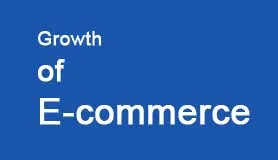Growth of E-commerce in the Indian Market

I experienced buying grocery online first time in year 2006 from Tesco Stores in UK and the idea hit me so much that I shopped online almost every week on eBay for next one quarter. Year 2006 was probably not too early to adopt shopping online, but I see people still thinking it safe to visit shops rather than buying from web portals. One of the recent surveys on adaptability of online shopping amongst Indians; confirms that 75% of online purchase happens in India on tour and travel related websites. I believe, credit goes to Indian Railways for making it so large for the travel industry. Buyers and Entrepreneurs have different queries and concerns when it comes to e-commerce. Some of those are valid and others are simply myths.Users’ queries and concerns about e-shopping
Buyers think that shopping online is insecure because their card details may be saved by vendors on their portals and they may use that information later. This is a myth. Nothing of such sort happens. Transaction happens through secured payment gateways, which are kind of extended third party bank partners. Some of the well-established payment gateways in the Indian market are CCAvenue, BillDesk, PayU, ICICI Payment Gateway, HDFC Payment Gateway, etc.
Another concern is that products delivered may not be of the quality promised by the portal. This may hold valid for perishable products, but it is very much safe if we buy packaged food online. I buy my monthly grocery online and I have never encountered such problems ever. Otherwise also, online vendors are vigilant enough to take such concerns on priority and they commit to replace such items with immediate effect.
For any reason, if the transaction does not happen successfully, then there is a fear of losing the money paid. This is also a myth. The whole process is systematized. If transaction fails, in between, due to website failure or due to low internet speed or for any other reason and if amount gets debited from your account, intimation appears immediately and the money is reverted back to your bank account within 48 working hours. Though I would suggest saving the failure reference no, in such cases, for future communication with service providers or your bank.
Clients like to shop from outlets, where they can shop on credit. This is relaxing on customers’ budgets. Same facility can be availed while shopping online too. Use your credit cards wisely for shopping online and you may avail credit period of maximum 50 days. Even on the payment due date, you can divide your payments in EMIs.
Shoes, apparels or other such accessories shopped online may not fit in size or might carry some other similar concerns. This should not be a problem if the user is already using similar products of the same brand. In case user still faces such a problem, then vendors’ policies are lenient enough to change items.
Benefits of shopping online
To end user: No traveling, no parking struggles, saves fuel and parking money, no need to stand in queues for paying bills, healthier way to shop, can place orders while traveling using m-commerce. Better options and choices. There are portals which facilitate users to compare prices and discounts available at different vendors.
To shop owner: No need to invest in real estate, reduces pain of maintaining huge inventories, easier accountancy, can collect orders 24/7/365 days, prevents stationary and staff expenses, can provide better customer service, can server bigger customer base and it allows them to receive payments faster.
Social benefits: Prevents pollution and crowd on roads, saves energy (Fuel, Electricity and Manpower).
Real problems in growth of Indian online market
High installation and service charges of payment gateway companies: Currently installation charges of different PG companies range from INR-30000 to 40000 and on top of this based on different payment modes and plans, these companies charge 3% to 7% commission on every online transaction. Web developer also charges fee for integrating online payment facility on vendor’s portal. This whole investment is too high to convince a vendor to open his online shop for an experiment. Reduction in this investment cost is mandatory for online shopping success in India.
Lower internet speed: Indians are still using low speed internet services for their home use because availing higher speed, needs costlier plans. This prevents people from opting online shopping.
Red tapeism in providing credit cards to people: I am sure that not every household in Indian metro cities carries at least one credit card. I understand that banks have their own reasons to keep a check on distributing cards, but efforts to increase credit cards user base will obviously help in growth of Indian online market.
Lack of knowledge about using the services: I know some friends who had bitter experience of using Credit Cards, because they missed paying their dues on time. Proper knowledge about how can users use credit cards for efficient shopping or how can they use debit cards or Netbanking for online shopping, if they do not like to use credit cards, will certainly encourage e-commerce in India.
There is a long list of questions from entrepreneur too. I’ll talk about them in my next article on “e-commerce growth in Indian market – II”
I am sure a time will come soon when physical shops shall be used only for displaying working demos of products and people will prefer buying everything online only.







